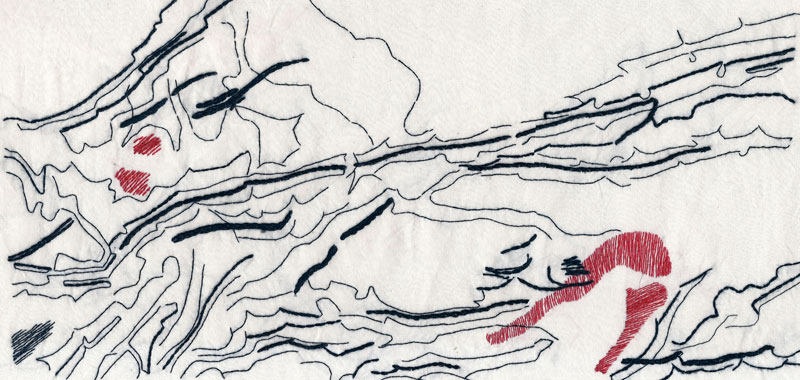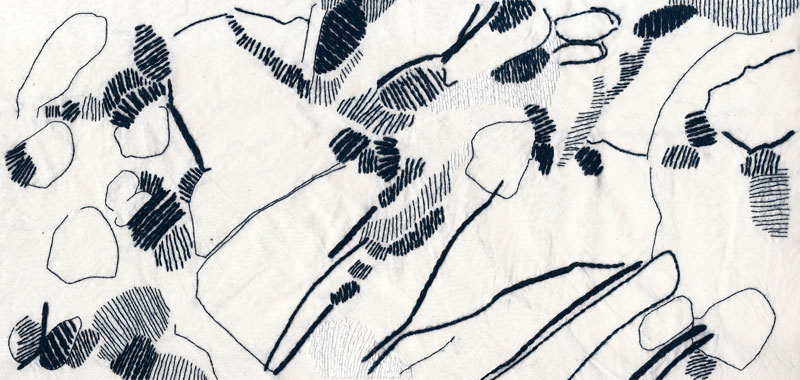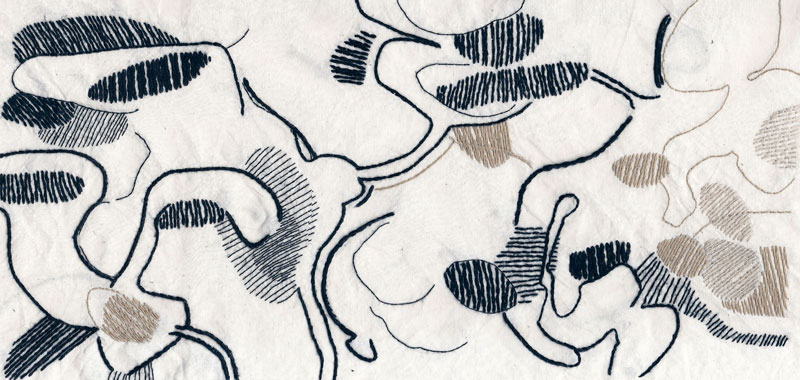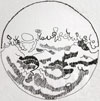| home rebecca agnes | books | texts | links | bio | cv |
 |
|
Mars Ricamo a mano su cotone, 29.7 x 42 cm, 2011. Giovanni Schiapparelli disegnò diverse mappe della superficie di Marte basandosi sulle sue osservazioni telescopiche. Attribuì nomi ai continenti e ai mari del pianeta. A causa dell’errata traduzione della parola “canali” in inglese, canals al posto di channels, derivarono varie ipotesi di vita su Marte. Ho ridisegnato la mappa del pianeta basandomi su quelle di Schiapparelli, sostituendone i nomi con titoli di romanzi di fantascienza collegati con il pianeta Marte. |
Mars Needle-work on cotton, embroidered by hand, 29.7 x 42 cm, 2011. Giovanni Schiapparelli drew different maps of the surface of Mars based on his telescopic observations. He named the “continents” and the “sea” of the planet. Because of the wrong translation in English of the Italian word “canali” (“canals”, instead of “channels”) various assumptions about life on Mars were made. I drew a map of the planet based on the maps of Schiapparelli, in which the original names are replaced by the titles of science-fiction novels connected to Mars. |
 |
|
Jupiter Ricamo a mano su cotone, 29.7 x 42 cm. Giove appare visibile a occhio nudo grazie alla sua elevata albedo. Nel XVII secolo Galileo Galilei appurò l’esistenza di alcuni dei satelliti del pianeta. Gian Domenico Cassini scoprì la macchia rossa di giove: l’occhio di un uragano che imperversa da secoli sulla superficie del pianeta. |
Jupiter Needle-work on cotton, embroidered by hand, 29.7 x 42 cm. Jupiter is naked-eye visible due to its high albedo. In XVII century Galileo discovered some of its satellites. Gian Domenico Cassini noticed a red spot on its surface: the eye of hurricane that rages on the planet since centuries. |
 |
|
Mercury Ricamo a mano su cotone, 29.7 x 42 cm. Questo ricamo è basato su una mappa dell’albedo della superficie di Mercurio realizzata in Russia nel 1978. Durante il giorno è impossibile osservare il pianeta a causa della luminosità solare, è visibile solo al tramonto o poco prima dell’alba e solo in specifici periodi dell’anno. |
Mercury Needle-work on cotton, embroidered by hand, 29.7 x 42 cm. That needle-work is based on a Russian map of the albedo of Mercury from 1978. During the day it is impossible to observe the planet due to the brightness of the sun. Mercury is visible only at the sunset or at dawn only in few periods of the year. |
 |
|
Neptune Ricamo a mano su cotone, 29.7 x 42 cm. Era già stato osservato da Galileo nel 1612, ma era stato scambiato per una stella fissa. Di fatto Nettuno è stato il primo pianeta trovato utilizzando calcoli matematici più che tramite osservazione. John Couch Adams e Urbain le Leverrier, rispettivamente nel 1846 e nel 1847, calcolarono l’ipotesi della sua posizione. |
Neptune Needle-work on cotton, embroidered by hand, 29.7 x 42 cm. Neptune was observed by Galileo in 1612, but it was mistaken to be a star. In fact Neptune is the first planet that was discovered through mathematical calculation instead of observational astronomy. John Couch Adams and Urbain le Leverrier, respectively in 1846 and in 1847, calculated the hypothetical position of the planet. |
 |
|
Pluto Ricamo a mano su cotone, 29.7 x 42 cm. L’esistenza del pianeta Plutone era stata ipotizzata più volte nel passato, anche dallo scrittore H.P. Lovecraft. E’ nel 1930 che Clyde Tombaugh riusce a fotografarlo utilizzando un apparecchio di sua invenzione che consente di fotografare la stessa zona di cielo in giorni diversi. Le foto del 23 gennaio e del 29 gennaio 1930 mostrano lo stesso corpo celeste in due posizioni diverse: è il movimento del pianeta rispetto alle stelle. |
Pluto Needle-work on cotton, embroidered by hand, 29.7 x 42 cm. The existence of the planet Pluto was hypothesised many times in the past, even by the writer H.P. Lovecraft. In 1930 Clyde Tombaugh took a picture of the planet, using a special device that he had invented, that allowed to take a picture of the same area of the sky in different days. The pictures of January 23 and January 29 of 1930 show the same celestial body in two different position: it’s the movement of the planet in comparison to the stars. |
 |
|
Uranus Ricamo a mano su cotone, 29.7 x 42 cm. John Flamsteed osservò Urano per la prima volta nel 1690 e lo scambiò per una delle stelle della costellazione del Toro. Nel 1781 William Herschel lo classificò inizialmente come cometa, poi come stella (chiamandolo Georgium Sidus in onore di re Giorgio III) e infine come pianeta, Georgian Planet. Nell’edizione del 1795 dell’Atlas Cèleste, Urano è disegnato come una piccola stella di nome Herschel. Il colore ciano del pianeta sarebbe dovuto alla presenza di metano sulla sua superficie |
Uranus Needle-work on cotton, embroidered by hand, 29.7 x 42 cm. John Flamsteed observed the planet for the first time in 1690, but he mistook it for a star of the Taurus constellation. In 1781 William Herschel first classified Uranus as a comet, then as a star, named Georgium Sidus in honour of king George III, and at last as a planet, Georgian Planet. In the edition of the Atlas Cèleste in 1795, Uranus is drawn like a little star named Herschel. The cyan blue colour of the planet’s surface is due to the presence of methane. |
 |
|
Venus Ricamo a mano su cotone, 29.7 x 42 cm. Percivall Lowell ipotizzò erroneamente la presenza di canali sulla sua superficie, a supporto delle sue teorie realizzò una serie di schizzi basati sulle sue osservazioni telescopiche. In tempi recenti il pianeta è stato frequentemente scambiato per un ufo. |
Venus Needle-work on cotton, embroidered by hand, 29.7 x 42 cm. Percivall Lowell incorrectly hypothesised the presence of canals on the surface of Venus. To support his theory he realised sketches based on his astronomical observations. In recent times the planet is commonly mistaken for a Ufo. |
 |
|
Saturn Ricamo a mano su cotone, 29.7 x 42 cm. E’ l’ultimo pianeta visibile a occhio nudo conosciuto sin dall’antichità. Nel 1655 Christiaan Huygens teorizzò l’esistenza di un anello sottile che circonda il pianeta. La sua forma peculiare sarà oggetto di osservazione anche da parte di Galileo. |
Saturn Needle-work on cotton, embroidered by hand, 29.7 x 42 cm. Saturn is the farthest naked-eye visible planet known from ancient times. In 1655 Christiaan Huygens hypothesised the presence of a thin ring around the planet. His peculiar shape was also observed by Galileo. |
 |
|
Makemake Ricamo a mano su cotone, 20x 42 cm. Osservazione astronomica/ appare rosso, la superficie non è omogenea, ricoperta di nitrogeno e metano ghiacciato, tolina. |
Makemake Needle-work on cotton, embroidered by hand, 20 x 42 cm. Observational astronomy/ appears red, the surface is not homogeneous, covered by nitrogen and methane ices, tholins. |
 |
|
Haumea Ricamo a mano su cotone, 20x 42 cm. Osservazione astronomica/ una area scura presente sulla superficie bianca luminosa, ricca di minerali e composti organici, ghiaccio cristallizzato. |
Haumea Needle-work on cotton, embroidered by hand, 20 x 42 cm. Observational astronomy/ a dark red area on the bright white surface, rich in minerals and organic compounds, crystalline ice. |
 |
|
Eris Ricamo a mano su cotone, 20x 42 cm. Osservazione astronomica/ appare prevalentemente grigio, depositi di tolina, ghiaccio sulla superficie. |
Eris Needle-work on cotton, embroidered by hand, 20 x 42 cm. Observational astronomy/ appears almost grey, deposits of tholins, ices on the surface. |
 |
|
Cerere Ricamo a mano su cotone, 20x 42 cm. Osservazione astronomica/ caratteristica peculiare è la presenza probabile di due crateri circolari, uno dei quali con una regione più luminosa al centro. |
Ceres Needle-work on cotton, embroidered by hand, 20 x 42 cm. Observational astronomy/ Two dark features had circular shapes and are presumably craters, one of them was observed to have a bright central region. |
otto pianeti/ eight planets |
| NEXT |  |
| home rebecca agnes | books | texts | links | bio | cv |